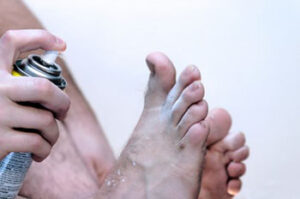 Athlete’s foot is a fungal infection that’s highly contagious and can be spread along your skin and affect your toenails. If you have a weaker immune system, you are also at greater risk of developing athlete’s foot.
Athlete’s foot is a fungal infection that’s highly contagious and can be spread along your skin and affect your toenails. If you have a weaker immune system, you are also at greater risk of developing athlete’s foot.
Athlete’s foot thrives in environments that are known to be damp, warm, or humid. Changing the environment can have a beneficial impact on reducing a flare up of athlete’s feet. Methods such as allowing shoe gear to dry well before next use, applying powder to the skin before wearing socks, and wearing moisture wicking socks can help. Topical treatment with over the counter antifungal cream or dilute white vinegar foot soaks may be an option. In some cases, topical or oral medication prescription may be necessary.
Those who are affected by athlete’s foot may experience symptoms such as cracking, dryness, flakiness, itchiness, redness, or scaliness of the skin of the foot or in between the toes. Oozing, crusting, swelling, and the formation of blisters are other symptoms that may arise due to athlete’s foot.
If athlete’s foot goes untreated, there is a high risk that it may spread from toe to toe. With this in mind, it’s highly recommended that you meet with a podiatrist and call our office to schedule an appointment for a professional diagnosis. Your podiatrist can give you information about treatment options that best suit your case.



